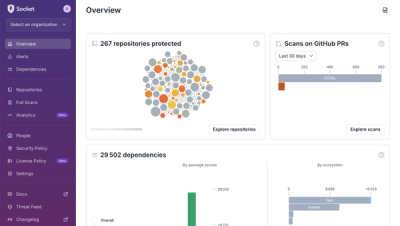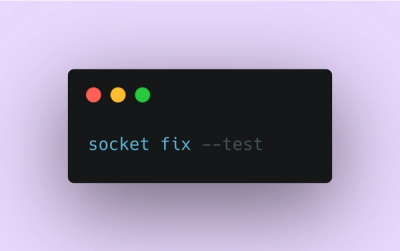
Product
A New Overview in our Dashboard
We redesigned Socket's first logged-in page to display rich and insightful visualizations about your repositories protected against supply chain threats.
pricing4react
Advanced tools
A library of components that ease the integration of feature toggling driven by pricing plans into your React application's UI.
The aim of this package is to provide some simple and easy to use components for react that allows UI feature toggling driven by pricing features. Also take a look to the package Pricing4Java, which allows fast and easy implementation of backend logic to be used by this package.
npm install pricing4react
The package uses JSON Web Tokens (JWT) to send from the backend, as well as authentication data, the evaluation of different pricing features for the user that makes the request. The JWT must be stored as a String in the local storage of the browser, with the name jwt. The token body must have the following structure:
{
"sub": String,
"exp": timestamp,
"iat": timestamp,
"authentication": {
...
},
"features": {
"feature1": {
"eval": bool or string,
"used": int,
"limit": int
},
"feature2": {
"eval": bool or string,
"used": int,
"limit": int
},
...
},
"userContext": {
...
},
"planContext": {
...
}
}
As you can see, with the 4 standard options of JWT, we have added a fifth: the features object. It contains the evaluation of the pricing features. The eval field could be a boolean that indicates the evaluation of the feature. used and limit are fields in which we can check the status of numerical limitations of the pricing plan. Specifically, used is the current use of the feature by the user (i.e 3 predictions made), and limit is the maximum number of times the feature can be used (i.e the user can perform up to 10 predictions). Both fields are optional, and if they are set to null, the feature will be considered as not limited. This could be interesting when we have simple boolean restrictions.
The eval field can also be a string that contains an expression that must be evaluated on the client side (for example, if it requires the previous evaluation of another feature). In this case, the expression must be a valid JavaScript expression, and the package will use the eval function to evaluate it. The expression can contain access the other two new paramenter on the JWT token's body: userContext and planContext. These two objects are used to store information about the user and the plan, respectively. They are optional, and if they are not present, they will be considered as empty objects.
As we said, you don't have to worry about the recreation of the JWT, since Pricing4Java will do it for you on backend. However, if you want to create your own JWT, as long as it follows the structure above, the package will be able to perform the toggling.
The package provides a single component that contains the whole logic:
Feature: This component allows to show or hide its children depending on the evaluation of a pricing feature. Depending on the context, it can have up to four children:
On: This component will be shown if the feature is evaluated to true. It has the prop expression, which reads from the JWT the evaluation of the feature. You can use the feature function to locate features by their key. REQUIREDDefault: This component will render its children if the evaluation of the feature performed in On component is false.Loading: This component will render its children while the evaluation of the feature is being performed.ErrorFallback: This component will render its children if an error occurs while the evaluation of the feature is being performed.The evaluation of a feature that has the key myFeature would be:
<Feature>
<On expression={feature("myFeature")}>
<p>Feature 1 is enabled</p>
</On>
<Default>
<p>Feature 1 is disabled</p>
</Default>
<Loading>
<p>Loading...</p>
</Loading>
<ErrorFallback>
<p>An error occurred</p>
</ErrorFallback>
</Feature>
Also a hook is provided to get the evaluation of a feature. Its name is useGenericFeature, and it could be used to get the evaluation of a feature and save the result on a variable. It has the following signature:
const myComponent = useGenericFeature({
on: [
{
expression: feature("myFeature"),
on: <p>Feature 1 is enabled</p>,
},
],
default: <p>Feature 1 is disabled</p>,
loading: <p>Loading...</p>,
errorFallback: <p>An error occurred</p>,
});
The package also provides a set of binary operators that can be used to combine the evaluation of different features. The operators are:
and: Returns true if the features are evaluated to true.or: Returns true if at least one of the features is evaluated to true.iff: Returns true if the features' evaluation is the same (in type and value).implies: Returns true if the logical implication between features is correct. Given two features: A and B, on which A implies B; if feature A is true, B must be. false will be returned if not.The usage of the operators is as follows:
<Feature>
<On expression={and(feature("feature1"), feature("feature2"))}>
<p>Feature 1 and feature 2 are enabled</p>
</On>
...
</Feature>
<Feature>
<On expression={or(feature("feature1"), feature("feature2"))}>
<p>Feature 1 or feature 2 are enabled</p>
</On>
...
</Feature>
<Feature>
<On expression={iff(feature("feature1"), feature("feature2"))}>
<p>Feature 1 has the same evaluation as feature 2</p>
</On>
...
</Feature>
<Feature>
<On expression={implies(feature("feature1"), feature("feature2"))}>
<p>Because Feature 1 is enabled, feature 2 must be</p>
</On>
...
</Feature>
FAQs
A library of components that ease the integration of feature toggling driven by pricing plans into your React application's UI.
The npm package pricing4react receives a total of 68 weekly downloads. As such, pricing4react popularity was classified as not popular.
We found that pricing4react demonstrated a healthy version release cadence and project activity because the last version was released less than a year ago. It has 0 open source maintainers collaborating on the project.
Did you know?

Socket for GitHub automatically highlights issues in each pull request and monitors the health of all your open source dependencies. Discover the contents of your packages and block harmful activity before you install or update your dependencies.

Product
We redesigned Socket's first logged-in page to display rich and insightful visualizations about your repositories protected against supply chain threats.

Product
Automatically fix and test dependency updates with socket fix—a new CLI tool that turns CVE alerts into safe, automated upgrades.

Security News
CISA denies CVE funding issues amid backlash over a new CVE foundation formed by board members, raising concerns about transparency and program governance.